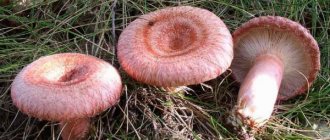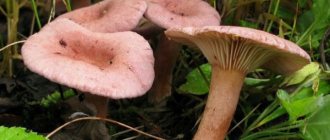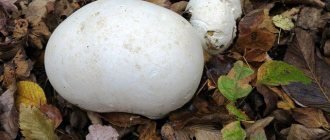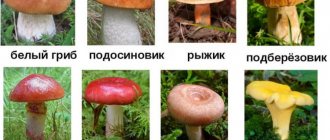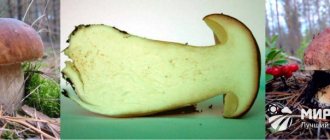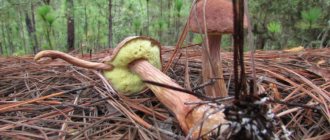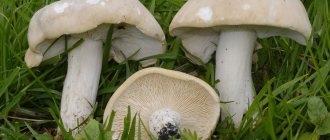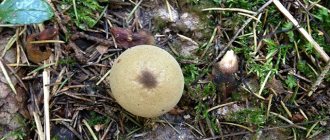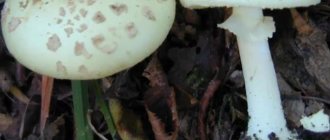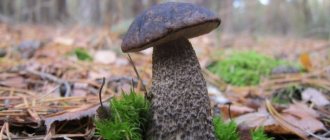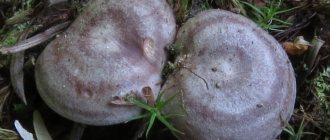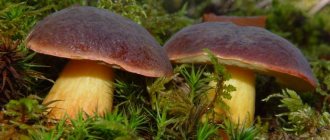Some of the most popular mushrooms in our country are considered to be mushrooms and saffron milk caps. These species are very similar and it can be extremely difficult for an inexperienced mushroom picker to distinguish them. Both volushki and saffron milk caps belong to the genus Mlechniki, which is characterized by the absence of fibers in the pulp. If you break such a mushroom, you can see juice or white liquid.
For most representatives of this genus, the juice is considered poisonous, but both saffron and saffron milk caps do not pose a danger to humans. Residents of Europe consider these species to be inedible, but in Russia they are collected and eaten pickled or salted. These two species are very similar, but in fact they have many differences. Visually, the difference between saffron milk caps and saffron milk caps can be seen in the photo. In addition, each type has other differences.
Milky mushrooms
The main feature of such mushrooms is the lack of fiber. When broken, most of them release juice or white milk. For many of them it is poisonous. Therefore, in Europe these mushrooms are considered inedible, while in Russia many people collect them and happily eat them salted or pickled. Before cooking, they must be soaked and then boiled in salted water. In addition to saffron milk cap and milkweed, milkweeds include: milk mushrooms, rubellas, serushkas, and spurge. The main habitat for these fungi is wet, wetlands. They can be found both in birch and mixed forests, and in spruce forests.
The most common species found in Russian forests are saffron milk cap and roseate, which have much in common, but at the same time are noticeably different.
Differences in primary processing
It is easier to wash and process volnushki. But the harvested harvest of these milkweeds must be soaked for about three days until the bitterness goes away. At the same time, the water is changed periodically. Only after soaking can they be used for pickling and boiling. Even from the time of salting, they wait no less than 1.5 months. But then there are few mushrooms tastier than pink trumpet mushrooms.
Pink volnushka is usually used for pickles or pickling. Before harvesting procedures, these mushrooms are soaked and blanched for a long time. Otherwise, these representatives of the mushroom kingdom will be bitter and somewhat toxic. So you should remember that the danger of being poisoned by these milkweeds is still great. Although this mushroom is not deadly, it can cause harm to health, causing vomiting, headaches and other unpleasant symptoms.
This will happen if the wave is prepared incorrectly. It can also cause gastrointestinal upset. Therefore, if a person is unfamiliar with this mushroom and the technology for its processing, it is better to refuse it. Ryzhiki can be used almost immediately. In addition, these milkweeds do not need to be soaked; they can also be fried.
In addition to everything, the mushroom also contains a very large amount of chitin, which reduces the benefits of the mushroom to zero. Saffron milk caps have almost no such substance.
The main differences between saffron milk caps and saffron milk caps
Despite the fact that they belong to the same family, there are a number of differences between saffron milk cap and volnushka. Let's compare them and find out what the main differences are:
- Color. The saffron milk caps have a bright pink tint, while the saffron milk caps are orange.
- Also, saffron milk caps have a shaggy cap, while saffron milk caps have a smooth cap.
- When broken, white milk is released from saffron milk caps, while saffron milk caps have a bright orange color.
- When heat treated, the pink volnushka changes color to light gray, and the camelina darkens.
- The inner surface of the saffron is light pink, while the saffron milk cap can vary from bright orange to green-blue. It depends on the age of the mushroom.
- Volnushka is considered a more unpretentious mushroom and grows mainly in birch groves. Finding saffron milk caps in the forest is a real find, since this mushroom likes to grow only in ecologically clean forests. By the way, you can only find it in pine or spruce forests.
- Another striking feature of the pink wave is the presence of clearly visible circles on the cap.
- Ryzhiki are mostly delicious mushrooms. Many even claim that their taste is superior to the much-vaunted porcini mushrooms and milk mushrooms. In addition, saffron milk caps do not require long soaking before cooking. In the old days they were even consumed fresh.
- Volnushki are the most commonly found mushrooms, along with russula. Before cooking, they need to be soaked for a long time in cold water; it is better to leave them for several days.
- These mushrooms also differ in size. The saffron milk caps are larger.
- When cut, the pink volnushka does not change its color; in the saffron milk cap it becomes greenish-blue.
Description and characteristics of mushrooms
Let's take a closer look at both of these types.
Saffron milk caps
They are considered the most delicious milk mushrooms. According to most gourmets, their taste is not inferior to porcini mushrooms. Small mushrooms (up to 2.5 cm in diameter) were previously considered a delicacy.
There are several types of saffron milk caps:
- hog;
- milky red;
- real;
- spruce.
The hat has a round shape, a diameter from 5 to 18 cm, and is colored red-red or yellow.
The upper surface of the cap has dark round spots and becomes sticky after rain. Young saffron milk caps have a convex cap; with age, its edges bend upward. In hog and milky red saffron milk caps, the lower part of the cap is covered with plates and becomes flat or concave.
Real camelina can be distinguished from other varieties by its cap: it has a glossy surface, colored brown, yellow, red or orange, sometimes covered with a whitish coating.
The leg is painted in the same shade as the cap, round in cut, and breaks easily. As the mushroom ages, a hollow channel appears and expands inside the stem.
Volnushki
The name of the mushroom does not come from the word “wave,” as one might easily think, but from the Old Slavonic word “vovna” (wool).
Attention! Pink mushrooms are a conditionally edible species of mushroom. Without fully knowing how to prepare trumpets, you risk getting poisoned. In this case, there is no risk of death, but headache, fever, gastrointestinal upset, nausea and vomiting may occur.
Volnushki are easy to wash, but fresh mushrooms have a bitter taste and contain some toxins.
To make these fruiting bodies tasty and harmless, they are soaked for at least 3 days, periodically changing the water, and only then boiled and salted.
After salting or pickling, mushrooms are consumed no earlier than 1.5 months later. This makes them taste better, although it reduces their nutritional value.
Beneficial features
Many people compare the benefits of eating vodka with saffron milk caps. However, their beneficial properties are slightly different.
Volnushki
They contain large quantities of vitamin A, which has a beneficial effect on vision. In addition, these mushrooms are recommended by all nutritionists, since their calorie content is very low. They also contain essential amino acids for the body, vitamins B and C, necessary for hair and skin cells.
Saffron milk caps
They contain beta-carotene, which is essential for vision. Fiber regulates digestion. Minerals have a beneficial effect on the condition of skin and hair. In addition, these mushrooms contain the valuable antibiotic lactarioviolin, so it is often used to treat inflammatory diseases caused by bacteria and viruses.
How to cook (processing and cooking)
Rizhiki are mushrooms of the first category, from the Milky family. They can be cooked immediately without soaking first. recipes with saffron . They can be fried, boiled, salted, pickled or frozen for the winter.
And although salted fruits acquire a greenish-brown tint, this does not affect their taste at all. They even make okroshka with them.
- Mushrooms must be cleaned before cooking. It is better to do this with a soft brush, carefully removing the remaining litter and leaves.
Advice! You should not wash saffron milk caps, as after contact with water the mushrooms partially lose their flavor and the caps become brittle.
- It is necessary to check the caps to ensure there are no worms in them. And the affected areas need to be removed.
Watch the video! How to deliciously pickle saffron milk caps
Contraindications
In general, mushrooms are a rather heavy food and are not equally beneficial for everyone. Therefore, before using them, you need to familiarize yourself with the contraindications. So, it is not recommended to eat saffron milk caps and red mushrooms if you have:
- Diseases of the gastrointestinal tract.
- Cholecystitis and other liver diseases.
- Kidney diseases.
- Constipation.
- Pancreatitis.
- Low acidity.
In addition, their use is prohibited during pregnancy and lactation, and they should not be given to children under 5 years of age. Children from 5 to 14 years old - only occasionally and after good heat treatment.
It should be remembered that mushrooms are capable of absorbing and accumulating toxins, so they can only be collected in clean places. Despite their good chemical composition, they should be consumed carefully in small quantities.
False saffron milk caps (doubles)
Saffron milk caps are valuable edible mushrooms of the Milky genus, which, when broken, secrete abundant orange-red milky juice. The advantage of this characteristic is that they cannot be confused with inedible and dangerous species.
However, due to inexperience, other, not so tasty and aromatic mushrooms of this genus, classified as conditionally edible, can be mistaken for the noble saffron milk cap.
Pink trumpet (Lactarius torminosus)
It is characterized by white milky juice that does not darken in air. This mushroom grows in deciduous forests at the roots of birch trees and is more common in northern regions. In addition to the white color of the milky juice, the pink wave is distinguished by a soft pink cap with fringed edges turned down and whitish flesh at the break.
Eating pink salmon if it is not properly boiled or salted for less than 45 days can cause problems with the functioning of the stomach and intestines.
Large milkweed or papillary breast (Lactarius mammosus)
Another conditionally edible mushroom of the same genus, growing in coniferous forests, often on light sandy loam. It is distinguished by a grayish-brown dry cap and white milky juice that does not darken in air. The pulp is white, brittle; if you rub it between your fingers, you can smell a faint coconut smell.
This species is used for food after soaking and prolonged salting.
Fragrant milkweed (Lactarius glyciosmus)
A small mushroom with a cap diameter of up to 6 cm, which is characterized by a beige or ocher color and rolled up edges. The pulp is light, the milky juice is white, does not change color, the smell is strong, coconut.
It is used as a spicy additive to other dishes and in pickled form.
Ryzhiki and volnushki, how to cook. Saffron milk caps, volushki, milk mushrooms. Salt and eat
Instead of enjoying the whole family on a cold autumn day, when there is still a little rain, for example, the beautiful sounds of classical music in the Philharmonic, crowds of people, young and old in boots, comb the coniferous forest up and down. And, imagine, we are no less happy! And happiness lies in feeling the process of searching, collecting and ultimately getting such a pleasant sluggish fatigue throughout the body. Well, and a trunk full of mushrooms to boot.
So what to do?! For mushrooms - in any weather... There are quite a lot of people who love to pick mushrooms, but to process them - well, no, not at all! It’s better to distribute it to friends. When picking mushrooms, laziness is not my element, so in the fall, mostly on weekends, welcome red-haired guests from the young pine forest appear at home. All that remains is to quickly process and cook them. It’s not at all difficult to pickle saffron milk caps, white milk mushrooms or milk mushrooms so that they turn out very tasty. Therefore, those who do not like to tinker with mushrooms for a long time can use the simplest recipe for preparing them for future use.
Salty waves
- We thoroughly wash the collected mushrooms from sand or forest soil (it is better to do this immediately after collection), at the same time immediately selecting small and large ones into different basins. Large ones can be cut into two or four pieces.
- Then we put them in dense layers in containers (I use large pots or buckets of 10-12 liters), filling each layer with salt so that it covers the mushrooms. If you overdo it with salt, then always rinse them briefly under water, especially since everyone has their own idea of the level of salinity. Over time, your hand knows exactly how much salt to put in according to your taste.
- When adding another layer of mushrooms, do not forget to evenly distribute black peppercorns, allspice, whole cloves (5-7 pieces each) and two bay leaves. Additionally, add a small piece of whole cinnamon to each layer; when salted cold, it will give the taste of the mushrooms a slightly noticeable pleasant shade without giving away too much. Whole cinnamon can be bought at the market, where spices are sold by weight. Fill the container three-quarters full.
- We place a cover on the mushrooms (an inverted lid, a flat plate or a circle of plywood), and put a load on top (a three-liter jar of water, etc.).
- We put everything in a cool place (a must), and if there are very few mushrooms, the bottom shelf of the refrigerator will do. After a few days, the mushrooms will settle under the weight of the load and become compressed.
- After 10 days, the compressed layers of mushrooms can be carefully transferred in parts as tightly as possible into smaller, pre-sterilized jars and filled with the resulting excess brine.
Saffron milk caps. All that remains is to remove the air and add brine
- There should be no air left in the jars, otherwise during storage the mushrooms at the very top of the jar will darken. Therefore, using a clean spoon or knife, carefully release the air from the formed air pockets, then add salted brine to the top and close the lid. You can use any lids for this cooking method.
- After this, we take the jars to the cellar or leave them in the refrigerator. Long-term storage of such mushrooms should only be in a cool place. After 6 weeks, mushrooms can be eaten.
It would be more correct to say - you need to eat... For these types of mushrooms, you can also use hot salting, which will take more time, and you will need to add vinegar. But, in my opinion, it is with cold salting, especially saffron milk caps and milk mushrooms, that their native, special taste is most fully preserved.
